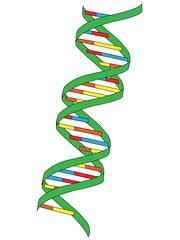AP BIology DNA Replication Flashcards
Terms : Hide Images [1]
| 16635007323 | DNA Replication | process by which DNA molecule is copied; DNA synthesis (S stage of interphase) |  | 0 |
| 16635007324 | Transformation | a change in genotype and phenotype due to the assimilation of external DNA by bacteria |  | 1 |
| 16635007325 | Bacteriophages | Viruses that infect bacteria Bacteria eaters |  | 2 |
| 16635007326 | Virus | infects a cell and takes over the cell's metabolic machinery |  | 3 |
| 16635007327 | Hershey and Chase | Concluded that viral DNA entered bacterial host cells, but viral proteins did not, so DNA fis the genetic material |  | 4 |
| 16635007328 | Chargaff's Law | the base compostion of DNA varies between species and for each species, the percentages of A and T bases are roughly equal to the percentages of the G and C bases | 5 | |
| 16635007329 | Rosalind Franklin | X-ray crystallographer that discovered the double helix of DNA |  | 6 |
| 16635007330 | Watson and Crick | discovered the structural double helix model of DNA | 7 | |
| 16635007331 | Double helix | two twisted strands |  | 8 |
| 16635007332 | Antiparallel | subunits run in opposite directions |  | 9 |
| 16635007333 | Nitrogenous bases of Dna | A, T, C, G |  | 10 |
| 16635007334 | Purines | A and G Nitrogenous bases with two organic rings |  | 11 |
| 16635007335 | Pyrimidines | C and T Nitrogenous base with a single organic ring |  | 12 |
| 16635007336 | Semiconservative Model | the two strands of the parental molecule separate and each functions as a template for synthesis of a new complementary strand- most common |  | 13 |
| 16635007337 | Origins of Replication | short stretches of DNA having a specific sequence of nucleotides |  | 14 |
| 16635007338 | Replication Fork | a Y shaped region where the parental strands of DNA are being unwound |  | 15 |
| 16635007339 | Helicases | enzymes that untwist the double helix at the replication forks, separating the two parental strands and make them available as template strands |  | 16 |
| 16635007340 | Topoisomerase | The untwisting of double helix causes tighter twisting and strain ahead of replication fork Relieve this strain by breaking swiveling, and rejoining DNA strands |  | 17 |
| 16635007341 | Leading strand | Strand that continuously adds nucleotides to the new complementary strand as the fork progresses |  | 18 |
| 16635007342 | Lagging Strand | The strand that DNA polymerase works away from the replication fork; Synthesized discontinuosly as a series of segments |  | 19 |
| 16635007343 | Okazaki fragments | Series of segments that are 1000-2000 nucleotides long |  | 20 |
| 16635007344 | DNA Ligase | joins the sugar phosphate backbones of all the Okazaki fragments into a continuous DNA strand |  | 21 |
| 16635007345 | DNA polymerase | Synthesizes new DNA strands by adding nucleotides to a pre-existing DNA strand |  | 22 |
| 16635007346 | Mismatch repair | Other enzymes remove and replace incorrectly paired nucleotides that have resulted from replication errors | 23 | |
| 16635007349 | Telomeres | Special nucleotide sequences at the ends of chromosomes TTAGGG is repeated between 100-1000 times Prevent the staggered ends of daughter molecule from activitating cell's system for monitoring DNA damage |  | 24 |
| 16635007354 | Avery, McCarty, McLeod experiment | Protein- and RNA-degrading enzymes had little effect on transformation, but enzymes that degrade DNA eliminated the transforming activity. |  | 25 |
| 16635007365 | complementary |  | 26 | |
| 16635007366 | nucleotide |  | 27 | |
| 16635007357 | Avery, MacLeod, McCarty | Proved that DNA is the hereditary material |  | 28 |
| 16635007358 | Hershey-Chase Experiment | Used radioactive material to label DNA and protein; infected bacteria passed on DNA; helped prove that DNA is genetic material not proteins |  | 29 |
| 16635007359 | template strand | DNA strand that provides the pattern for ordering, by complementary base pairing, the sequence of nucleotides | 30 | |
| 16635007360 | complementary nucleotides | A-T G-C | 31 | |
| 16635007361 | DNA directionality | one end has an exposed hydroxl group on the 3' carbon of deoxiribose and the other end has an exposed phosphate group on a 5' carbon |  | 32 |
| 16635007362 | DNA structure | consists of two long chains of nucleotides twisted into a double helix and joined by hydrogen bonds between the complementary bases adenine and thymine or cytosine and guanine |  | 33 |
| 16635007367 | antiparellel strands |  | 34 | |
| 16635007363 | Purine bases | have a double ring structure and include adenine and guanine. |  | 35 |
| 16635007364 | Pyrimidine bases | Single ring structure; Cytosine, Thymine, Uracil |  | 36 |
